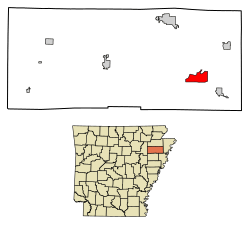Marked Tree, Arkansas facts for kids
Quick facts for kids
Marked Tree, Arkansas
|
|||
|---|---|---|---|
 |
|||
|
|||

Location of Marked Tree in Poinsett County, Arkansas.
|
|||
| Country | United States | ||
| State | Arkansas | ||
| County | Poinsett | ||
| Area | |||
| • Total | 5.81 sq mi (15.05 km2) | ||
| • Land | 5.77 sq mi (14.95 km2) | ||
| • Water | 0.04 sq mi (0.10 km2) | ||
| Elevation | 203 ft (62 m) | ||
| Population
(2020)
|
|||
| • Total | 2,286 | ||
| • Density | 396.05/sq mi (152.92/km2) | ||
| Time zone | UTC-6 (Central (CST)) | ||
| • Summer (DST) | UTC-5 (CDT) | ||
| ZIP code |
72365
|
||
| Area code(s) | 870 | ||
| FIPS code | 05-44210 | ||
| GNIS feature ID | 2405025 | ||
Marked Tree is a city in Poinsett County, Arkansas, United States. It is located along the St. Francis River, where the Little River joins it. In 2020, the city had a population of 2,286 people. Marked Tree is part of the Jonesboro, Arkansas, metropolitan area.
This area is also known for being near the southern end of the New Madrid Fault, which is a major fault line in the Earth's crust.
Contents
History of Marked Tree
The city's name comes from a special tree that stood on the bank of the St. Francis River until 1890. This tree was "blazed," meaning it had marks cut into its bark. These marks showed Native Americans a shortcut. Instead of paddling about 12 miles (19 km) upstream, they could walk about 120 yards (110 m) across land to reach the Little River. Marked Tree is sometimes mentioned on lists of unusual place names because of its unique origin.
Historically, in the late 1800s, there were times when African Americans were not allowed to live in Marked Tree.
Geography of Marked Tree
Marked Tree is situated on the St. Francis River. It is located where US Route 63 crosses with Arkansas Highways 140, 149, and 308. The southern part of the Marked Tree Floodway, which helps control water levels, is just west of the city.
The United States Census Bureau reports that the city covers a total area of about 2.3 square miles (6.0 km²). Most of this area is land, with a small portion, about 0.04 square miles (0.10 km²), covered by water.
Population Information
| Historical population | |||
|---|---|---|---|
| Census | Pop. | %± | |
| 1900 | 352 | — | |
| 1910 | 2,026 | 475.6% | |
| 1920 | 1,318 | −34.9% | |
| 1930 | 2,276 | 72.7% | |
| 1940 | 2,685 | 18.0% | |
| 1950 | 2,878 | 7.2% | |
| 1960 | 3,216 | 11.7% | |
| 1970 | 3,229 | 0.4% | |
| 1980 | 3,201 | −0.9% | |
| 1990 | 3,100 | −3.2% | |
| 2000 | 2,800 | −9.7% | |
| 2010 | 2,566 | −8.4% | |
| 2020 | 2,286 | −10.9% | |
| U.S. Decennial Census | |||
Marked Tree's Population in 2020
| Race | Number | Percentage |
|---|---|---|
| White (non-Hispanic) | 1,433 | 62.69% |
| Black or African American (non-Hispanic) | 680 | 29.75% |
| Native American | 1 | 0.04% |
| Other/Mixed | 106 | 4.64% |
| Hispanic or Latino | 66 | 2.89% |
According to the 2020 United States census, Marked Tree had 2,286 residents. These people lived in 922 households, and 585 of these were families.
Education in Marked Tree
The Marked Tree School District provides public education for students from prekindergarten through high school. Before 1966, there were separate schools for White children and Black children. The first school for Black students was built in 1938. From 1952 until it closed in 1966, it was known as George Washington Carver.
As of 2018, the Marked Tree School District includes:
- Marked Tree Elementary School, which serves students from prekindergarten up to 6th grade.
- Marked Tree High School, which serves students in grades 7 through 12.
Notable People from Marked Tree
- Fannie Lewis, who was the longest-serving councilwoman in Cleveland, Ohio, was originally from Marked Tree.
See also
 In Spanish: Marked Tree (Arkansas) para niños
In Spanish: Marked Tree (Arkansas) para niños



